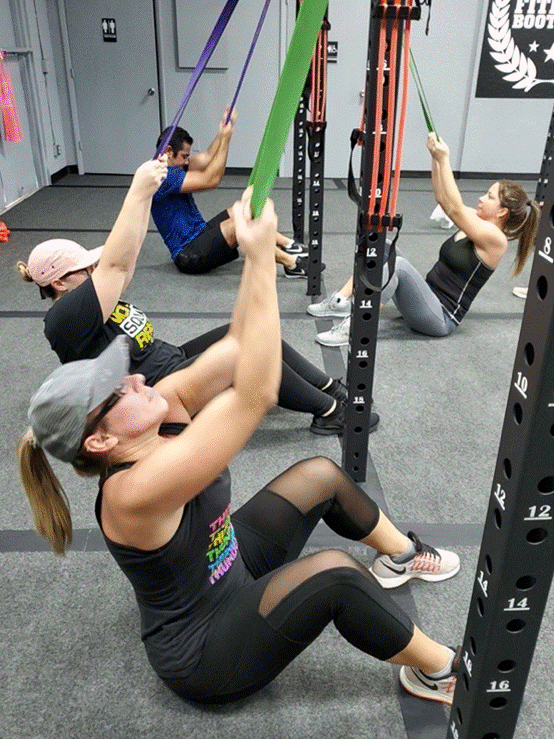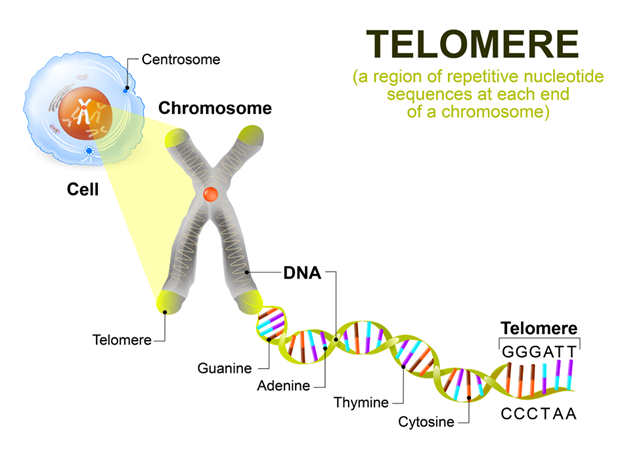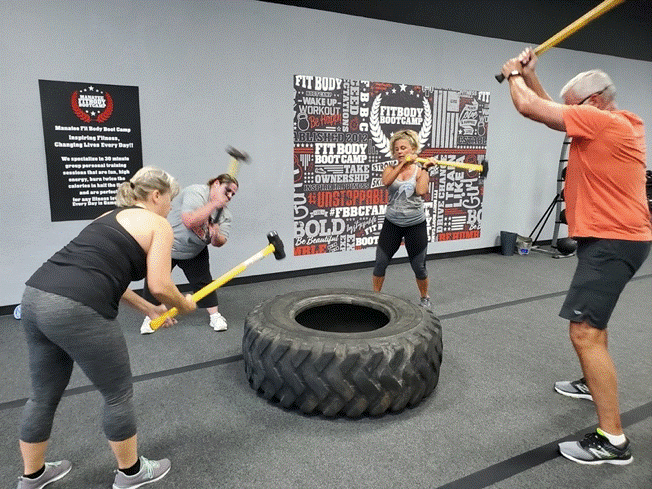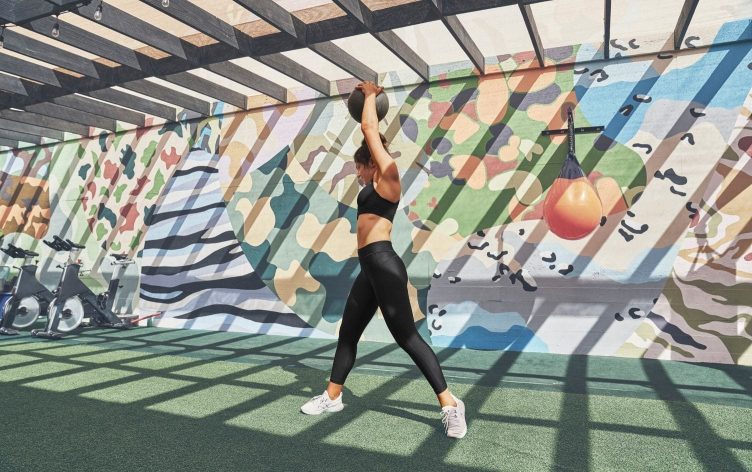1/6/2021
5 Best Workouts For Fat Loss, Ranked
When coupled with healthy food choices, regular exercise can help you reach your fat-loss goal. However, with so many exercises to choose from, picking the right ones for your fat-loss program can be daunting.
It turns out, the best approach is a combination of four different exercises: “Balance is key,” says Nick Briney, a senior personal training manager for Life Time in Kansas City, Missouri. “When you really want to optimize your ability to get the most burn out of a workout, incorporating all of these activities will be crucial.”
Here are the best exercises ranked from most calories burned to least.
High-intensity interval training (HIIT) tops the list of best fat-loss exercises. “You’ll get a lot done in a shorter timeframe because higher intensity exercise is going to lend itself to a higher calorie burn before and after the workout,” Briney says.
Part of the reason HIIT is effective for fat loss is it maximizes your excess post-exercise oxygen consumption (EPOC), or the amount of oxygen your body consumes while your muscles and other tissues return to their pre-exercise state. This process keeps you burning calories once your workout is over. The more intense the exercise, the more calories you burn post-workout.
According to a small study published in the February 2014 issue of Applied Physiology Nutrition and Metabolism, men burned as many calories over the course of 24 hours from a 20-minute HIIT session as a 50-minute steady-state cycling session.
Sample workout: The Tabata protocol is a common — and quick — form of HIIT training. To try it, do eight 20-second rounds of exercise at an all-out intensity, and take just 10 seconds of rest between rounds. Pick an exercise that will get your heart rate up in a flash (e.g., sprints, kettlebell swings, squat jumps, burpees).
However, while HIIT is a top calorie-burning option, it also places a lot of stress on the body. To avoid injury and burnout, limit your HIIT sessions to two or three times per week, Briney says.
Cardio may burn more calories during the workout than resistance training (a 30-minute run at 6 miles per hour burns roughly 372 calories for a 155-pound person, while a vigorous weight session burns 223 calories), but resistance training builds muscle. That muscle then helps you burn more calories at rest (known as your basal metabolic rate), and if the strength session is intense enough, you’ll see greater EPOC, according to Briney.
Sample workout: Shoot for 2–4 strength sessions per week. In general, circuit-style strength sessions (i.e., moving right from one exercise to the next with little to no rest in between) likely burns more calories than taking regular breaks, as will pairing an upper-body exercise with a lower-body exercise, according to Briney. To save time, tack a quick HIIT session onto the end of your strength routine 2–3 times per week.
“This is hands-down the best way to burn fat calories,” Briney says. HIIT and other forms of intense exercise primarily burn carbs (officially known as glycogen), whereas less-intense forms of exercise (e.g., walking, swimming, jogging) will primarily burn fat. “People think burning a calorie is burning a calorie, but we don’t always burn calories from the same fuel sources, depending on the exercise,” Briney says.
Carb-burning exercise is great, but fat-burning exercise is generally less stressful on your body. In fact, you may be able to perform this type of cardio every day without the risk of overdoing it, Briney says. And fitting more movement into your day is a great way to increase your overall calorie burn. Plus, if you’re new to exercise, or you’re intimidated by more intense forms of exercise, low- to moderate-intensity cardio can be a great way to get regular movement.
Sample workout: Briney suggests making low- to moderate-intensity cardio your primary (70%) form of cardio. Options include walking, jogging, easy cycling, swimming and elliptical. Gauge your intensity according to your breathing patterns: If you’re able to sustain breathing in and out of your nose and say one or two sentences without much difficulty, you’re working at a low- to moderate-intensity, Briney says.
You might not readily associate mind-body exercises like yoga and Pilates with fat loss, but these kind of activities are key for creating balance and easing stress. “Stress often limits people from fat loss, from physical stress like old injuries and lack of mobility, to mental stress,” Briney says.
Whether you go for yoga, Pilates or a mix of the two depends on your goals and preferences. In general, Pilates helps you build core strength and improves posture and alignment, whereas yoga helps improve flexibility and balance. That said, there are many different types of yoga, from vigorous and fast-paced to slow and stretch-focused.
In general, yoga and Pilates can help ease mental and physical stress, but the best form of mind-body exercise for you is the one you enjoy.
Sample workout: “Like low- to moderate-intensity cardio, you could do yoga and Pilates more often without too much stress,” Briney says. At a minimum, though, try to do yoga and/or Pilates at least once a week.
Don’t think you need to do a planned workout to reap the weight loss benefits associated with movement. Increasing your daily activity levels via simple tweaks (i.e., taking the stairs instead of the elevator, breaking up long periods of sitting with quick walks) can not only help you burn more calories throughout the day (helping you lose or maintain weight), but it can also offset the negative effects of a sedentary lifestyle.
READ MORE > 63 MICRO-GOALS TO KEEP YOU HEALTHY (WITHOUT KNOWING IT)
According to research published January 2015 in the Annals of Internal Medicine, a sedentary lifestyle is associated with increased health risks, including heart disease, cancer, Type 2 diabetes, and death by any cause — even if you exercise. However, these health risks are less pronounced at higher physical activity levels.
Sample workout: Find ways to sneak physical activity into your day. A few options include:
- Set a phone alarm to go off at regular intervals while you work or watch TV and get up every time the alarm sounds. Walk around, do bodyweight exercises (e.g., pushups, sit-ups, jumping jacks, marching in place),
- Go for a 20-minute walk after meals.
- Drink more water throughout the day; this encourages more frequent trips to the bathroom.
- Walk to your co-worker’s desk instead of calling or emailing them.
- Take extra trips when unloading groceries or carrying laundry.
1/6/2021
Some trainers tout HIIT as the best way to burn belly fat. Here’s what science says.
Washington Post, 15 Dec 20, Pam Moore
Whether you consider a six-pack a goal or a beverage is beside the point when it comes to extra fat at your waistline. Abdominal adiposity — excess stomach fat — is associated with increased mortality risk, regardless of body mass index.
But although the exercise community has long known that it’s impossible to “spot train” to reduce inches anywhere on your body, some trainers have been touting high-intensity interval training (HIIT) as the best way to target stomach fat. The workout, which includes short bursts of intense work followed by short rest periods (think 30 seconds on, 30 seconds off), can take as little as 20 minutes. Before you start alternating burpees and jumping jacks with recovery intervals, however, let’s look more closely at that claim.
The skinny on fat
To understand HIIT’s role in health and longevity, you need to first understand that all fat is not created equal.
Two types of belly fat, subcutaneous fat and visceral fat, accumulate in your abdomen, but they look and act very differently. Subcutaneous fat is stored just underneath the skin, says Tom Holland, a Connecticut-based exercise physiologist and fitness consultant.
It’s visceral fat, however, that you should be concerned about. Nestled deeper in your abdomen, adjacent to your organs, it’s “almost like an endocrine organ” that poses serious health risks, Holland says.
Unlike belly fat, visceral fat is “metabolically active,” says endocrinologist Reshmi Srinath, director of the Weight and Metabolism Management Program at Mount Sinai Hospital. It produces molecules known as adipokines that can increase inflammation in various organ systems. Such inflammation is associated with chronic conditions, such as insulin resistance, higher glucose levels, diabetes, heart disease and fatty liver disease.
The fat-burning heart-rate zone is a myth: How exercise and weight loss really work
Your waistline measurement is generally an accurate predictor of excess visceral fat and the health risks associated with it. According to Srinath, who is board certified in endocrinology and obesity, women whose waists measure 35 inches or more and men whose waists measure 40 inches or more are at increased risk of conditions including heart disease, diabetes, hypertension, hyperlipidemia and obstructive sleep apnea.
But although a larger waist circumference and excess visceral fat generally “go hand in hand,” Holland says, this isn’t always the case. According to Evan Jay, a physician assistant and athletic trainer at Redefine Healthcare in New Jersey, some thin people who don’t appear to carry extra weight in their abdomen do have visceral fat. Meanwhile, there are people with larger waistlines who don’t have excess visceral fat.
The only way to know for sure what kind of fat you’re carrying in your stomach is through imaging, which, Srinath says, isn’t typically done in clinical practice. Instead, in addition to looking at waist circumference, your health-care provider will note clinical markers indicative of visceral adiposity, Jay says. These include low HDL cholesterol, high triglycerides, high blood pressure and high fasting blood glucose, all of which are associated with excess visceral fat.
HIIT to the rescue?
Can HIIT reduce stomach fat? The answer is yes, according to a 2018 meta-analysis, which looked at 39 studies involving 617 subjects. “HIIT significantly reduced total (p = 0.003), abdominal (p = 0.007), and visceral (p = 0.018) fat mass,” the study’s authors said. What the authors did not say is that HIIT reduced fat better than other forms of exercise. And, in fact, studies have not found a difference in fat loss between HIIT and moderate-intensity continuous exercise in laboratory trials or in the real world.
“From a clinical perspective, there’s really no difference” between HIIT and moderate exercise, Srinath says. “The real benefit of HIIT,” she adds, is its efficiency.
Holland agrees. The “true beauty of a HIIT workout,” he says, is how little time it takes compared with moderate-intensity exercise, such as brisk walking, leisurely swimming or biking on a flat surface at a conversational pace. “When you look at a lot of studies,” he adds, “you’re getting the same results with high-intensity interval training in half the time.” And that, he says, helps people maintain their routine. He explains: “It’s, ‘Hey, I’m getting the same results — and in half an hour rather than an hour. I’m more likely to be consistent.’ ”
HIIT training also has potential cardiovascular health benefits. A 2019 meta-analysis reviewed 22 researched articles comparing HIIT training with moderate-intensity training. The authors found that when subjects’ total energy expenditure was equal, HIIT and moderate training produced similar reductions in weight, body fat, total cholesterol and cardiorespiratory fitness, all of which reduce the risk of cardiovascular disease. However, the HIIT subjects spent less time working out than their counterparts; their sessions were about 10 minutes shorter than the moderate exercisers’ sessions.
Also, because HIIT workouts tend to be shorter, participants may be more likely to avoid “compensatory eating,” says Holland. In other words, you might be less prone to “rewarding” yourself with a bigger portion or a dessert after a 25-minute HIIT session versus a 45-minute jog.
In fact, because fat loss depends on an overall caloric deficit, exercise alone won’t necessarily drive results. According to Jay, fat reduction has more to do with your meals than your workouts. Anybody interested in starting a HIIT program who hasn’t started looking at their diet, he says, “should take all that energy and redirect it.”
What to expect from HIIT
None of this is to say that you shouldn’t give HIIT a try. There are many ways to do it; the type of exercise doesn’t matter, as long as you get your heart rate into the “red zone,” Holland says. Common moves include compound (multi-joint) movements, such as variations on burpees, squats and lunges, “due to their relative difficulty and concomitant high heart rate response.”
If arthritis or other mobility issues preclude you from high-impact movements, you can turn any low-impact workout, such as cycling, swimming or using the elliptical, into a HIIT workout. All you need are a timer and some motivation.
According to the American College of Sports Medicine, the work periods should range from five seconds to eight minutes and be performed at 80 percent to 95 percent of your maximum heart rate. The time commitment varies, but it can take as little as 20 minutes.
If you don’t know your maximum heart rate or don’t have a heart-rate monitor, Holland suggests going by feel, or rate of perceived exertion (RPE). On a 0 to 10 RPE scale, shoot for eight, nine or 10 during your work intervals. To maintain the intensity throughout the session, he suggests shorter intervals, ranging from 20 seconds to a minute. “You’re outside your comfort zone, but you’re not staying there very long.”
Pace yourself, so by the time your work interval is complete, you’re out of breath. “And right at that point where you finally catch your breath, it starts again,” Holland says. Your ratio of work to recovery time can be adjusted to accommodate your fitness level, but it should generally range from 1:4 to 1:1. This might look like a minute of burpees followed by two minutes of recovery or 20 seconds of jump squats followed by a minute of recovery.
Although you might be tempted to minimize your recovery time in pursuit of a more intense workout, that strategy can be counterproductive. “If you cut [your recovery] too short,” Srinath says, “you can’t go at a high intensity for the next interval.”
Holland says a 25-minute HIIT session might include five one-minute rounds of high-intensity exercise, each followed by two minutes of recovery, sandwiched between a five-minute warm-up and a five-minute cool-down.
Regardless of what moves and time intervals you use, it’s important to vary your routine. As you get fitter, your body becomes more efficient — and you burn fewer calories. “Our bodies are very smart machines,” Holland says, so “we need to mix it up.”
To avoid injury and burnout, Srinath suggests incorporating HIIT into your routine two to three times a week; on other days, you can insert strength training and low-impact aerobic exercise, such as walking or swimming. Although the workout is appropriate for any age, if you’ve been diagnosed with a heart condition, you should exercise with medical supervision, Srinath says.
HIIT is an excellent choice for anyone who has time constraints and wants to optimize their long-term health — in other words, just about everyone, including beginners. No matter what your HIIT workout looks like, it will be done before you know it.
Pam Moore is a Boulder-based freelance writer, speaker, marathoner, Ironman triathlete and certified personal trainer.
https://www.washingtonpost.com/lifestyle/wellness/hiit-belly-fat-burn-workout/2020/12/14/b6ad8b7a-3668-11eb-8d38-6aea1adb3839_story.html
10/13/2020
Hi! My name is Steve Valley, and I’m the owner & a coach here at Bradenton Boot Camp & Fitness.
I occasionally get asked:
“WHAT IS HIIT?”
And “What’s different about HIIT compared to going for a jog, or aerobic exercise, or lifting weights at the gym?”
HIIT stands for High Intensity Interval Training. For anyone who hasn’t worked out in a while (or ever) we know that “high intensity” of anything sounds extremely intimidating, believe me, I get that, but keep reading and I’ll reassure you that this is JUST WHAT YOU NEED, and that you CAN do this!

HIIT simply means “working hard for short bursts, then resting for a short period, over and over, for about 20-30 minutes.” You don’t need to do a HIIT workout for 60 or 90 minutes… you get ALL of the benefits you need from pouring your effort and energy into a quick 20-30 minute workout.
The fact is, HIIT workouts burn the most fat, the most calories, out of any other workout. This isn’t opinion, this is fact. HIIT workouts fire up your body, enabling it to CONTINUE to burn calories at a high rate, for 24-36 hours after your workout! At Fit Body, we call this the ‘Afterburn’ effect!
WHY manatee FIT BODY boot camp?
Here at Bradenton Boot Camp & Fitness, we design our 30-minute workouts to include a 2-4 minute warm-up, followed by a HIIT workout, and finishing with a quick 2-3 minute cool-down/stretching. Our workouts change daily, and we meet you at YOUR level. About 30% of our new members tell us they haven’t workout out EVER or in a very long time. About 60% of our members tell us they need to lose 50+ pounds. Roughly 30% of our members tell us they need to lose 100 or more pounds. No matter what your goals are, you CAN do this, because people with your same concerns and goals come in every day and crush it!
We know that HIIT workouts aren’t a trend; they’re increasingly being researched for their health benefits for ALL ages – even those in their 70’s! (Check out this compelling article here!)
WHY HIIT?
Ok, I’m going to get a little nerdie right now, but hang with me. There are so many benefits to a good HIIT workout, but to name one specifically, a recent study discovered a correlation between HIIT workouts and our ‘telomere’ length. I had no idea what “telomere’s” were – but a quick google search revealed that we WANT telomere’s to be long – long telomere’s protect us! **I’ll be sure to link the article below so you can read all the details, but here’s the gist:
“The study compared the effects of different forms of exercise, including weight lifting, aerobic exercise, and HIIT on telomere length. Telomeres are part of human chromosomes, and their length shortens with age. Shortened telomeres are associated with disease and other age-related health problems.
At the end of a 26-week study period, individuals who did aerobic or strength training saw no change in telomere length. The HIIT group saw a “two-fold” increase in length.” [Please see below for the articles referenced]


I know that facts alone don’t always change our behavior, but I DO know that facts eventually inspire and compel people to change their story. At Bradenton Boot Camp & Fitness, we help you every step of the way, even if you’ve never worked out a day in your life – and even if you’re in your 70’s.
WE INVITE YOU IN FOR A FREE WORKOUT! (Free Class Sign-up)

Come on in and try us out for free – no strings attached. Let us help you re-write your health & wellness story. You have nothing to lose! CLICK HERE TO LEARN MORE. (Free Class Sign-up)
See you at Bradenton Boot Camp!
Have a wonderful day,
Coach Steve
For further reading, please check out this article by Gabby Landsverk on HIIT workouts and how they are linked to better mental health and longer, healthier lives:
https://www.insider.com/study-high-intensity-workouts-boost-health-in-people-over-70-2020-10
For further reading, please check out this article by Healthline:
https://www.healthline.com/health-news/switching-up-your-workout-routines-is-good-for-your-body-and-brain#What-is-neuroplasticity?
I love listening to podcasts when I am doing tasks that don’t require a lot of brain power, and one I’m enjoying listening to is Meathead Hippie! I love that they talk frequently about meditation and self-care AND lifting heavy – what a great combo! One of the episodes I caught the other day mentioned this Chinese Proverb:
The best time is now, my friend, and we are here to help you every step of the way.



